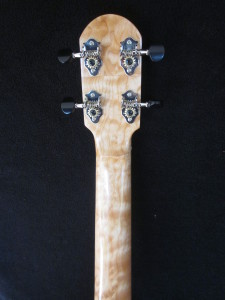I was speaking to a dealer in guitar wood. He said that if you ask any guitar maker “What is the most important characteristic of a piece of wood” they will all say “The sound it produces”. But – they all purchase wood based on the way it looks.
There is some truly spectacular wood available, for not much money, in the form of veneers. A veneer is also an ethical way to use any piece of wood, particularly a scarce and highly figured piece, since once can cut a great deal of veneer sheets from a piece of wood that would only yield a much smaller number of ‘boards’.
After some thinking and experimentation I have found a way to veneer the outside of a ukulele. This means that the sound is generated by the base wood, while the ‘look’ is from the veneer. Here is an experimental (on a number of levels) example.
This ukulele is constructed (sides and back) out of sycamore. The sycamore is a very nice wood, but the way these pieces were cut the pattern in the wood was more of a fleck, rather than strong medullary ray lines (see the sycamore ukuleles in the gallery). So I covered the sycamore with a pomele sapele veneer, which has a strong quilted or bubbly pattern. It worked out really well.
As part of the experiment: This ukulele has 2 tall thin fan braces under the top, rather than the more traditional shorter three braces. This seems to have yielded an increase in volume and sustain. It also uses a synthetic material “Richlite” instead of natural ebony (which is becoming very scarce and expensive) for the fingerboard and bridge. Richlite is very hard, dense, and being a synthetic material will not warp, expand/contract, or otherwise move around the way that a piece or real wood might.
- Back and Sides: Sycamore with pommelle sapele veneer
- Top: local spruce
- Neck: Quilted maple from Oregon
- Binding: curly maple
- Fingerboard, bridge: black Richlite
- Nut & saddle: bone
- Black-Red-Black purfling, Paua abalone rosette
- Headstock: book-matched curly maple with “Jupiter” planet inlay in red abalone pearl









